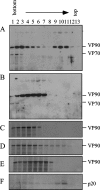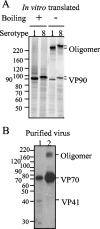Association of the astrovirus structural protein VP90 with membranes plays a role in virus morphogenesis
- PMID: 17652389
- PMCID: PMC2045458
- DOI: 10.1128/JVI.00785-07
Association of the astrovirus structural protein VP90 with membranes plays a role in virus morphogenesis
Abstract
VP90, the capsid polyprotein precursor of human astrovirus Yuc8, is assembled into viral particles, and its processing at the carboxy terminus by cellular caspases, to yield VP70, has been correlated with the cell release of the virus. Here, we characterized the effect of the VP90-VP70 processing on the properties of these proteins, as well as on their intracellular distribution. VP90 was found in membrane-enriched fractions (mVP90), as well as in fractions enriched in cytosolic proteins (cVP90), while VP70 was found exclusively in the latter fractions. Upon trypsin activation, infectivity was detected in all VP90-containing fractions, confirming that both mVP90 and cVP90 are able to assemble into particles; however, the two forms of VP90 showed differential sensitivities to trypsin, especially at their carboxy termini, which in the case of mVP90 was shown to remain membrane associated after protease digestion. Structural protein oligomers were detected in purified VP70-containing viruses, as well as in membrane-enriched fractions, but they were less evident in cytosolic fractions. Ultrastructural studies of infected cells revealed different types of viral particles, some of which appeared to be associated with membranes. By immunoelectron microscopy, structural proteins were shown to form virus particles in clusters and to associate with the edges of vesicles induced during infection, which also appear to contain subviral particles inside. Nonstructural proteins and viral RNA colocalized with mVP90, but not with cVP90, suggesting that mVP90 might represent the form of the protein that is initially assembled into particles, at the sites where the virus genome is being replicated.
Figures










Similar articles
-
Caspases mediate processing of the capsid precursor and cell release of human astroviruses.J Virol. 2004 Aug;78(16):8601-8. doi: 10.1128/JVI.78.16.8601-8608.2004. J Virol. 2004. PMID: 15280469 Free PMC article.
-
Role of individual caspases induced by astrovirus on the processing of its structural protein and its release from the cell through a non-lytic mechanism.Virology. 2010 Jun 5;401(2):322-32. doi: 10.1016/j.virol.2010.02.028. Epub 2010 Mar 29. Virology. 2010. PMID: 20347468
-
Crystal Structure of the Human Astrovirus Capsid Protein.J Virol. 2016 Sep 29;90(20):9008-17. doi: 10.1128/JVI.00694-16. Print 2016 Oct 15. J Virol. 2016. PMID: 27466429 Free PMC article.
-
The Astrovirus Capsid: A Review.Viruses. 2017 Jan 19;9(1):15. doi: 10.3390/v9010015. Viruses. 2017. PMID: 28106836 Free PMC article. Review.
-
Identification of structural domains involved in astrovirus capsid biology.Viral Immunol. 2005;18(1):17-26. doi: 10.1089/vim.2005.18.17. Viral Immunol. 2005. PMID: 15802951 Free PMC article. Review.
Cited by
-
New insights on the role of paired membrane structures in coronavirus replication.Virus Res. 2015 Apr 16;202:33-40. doi: 10.1016/j.virusres.2014.12.021. Epub 2014 Dec 27. Virus Res. 2015. PMID: 25550072 Free PMC article.
-
Detection of mink astrovirus in Poland and further phylogenetic comparison with other European and Canadian astroviruses.Virus Genes. 2021 Jun;57(3):258-265. doi: 10.1007/s11262-021-01834-z. Epub 2021 Apr 15. Virus Genes. 2021. PMID: 33860418 Free PMC article.
-
Does form meet function in the coronavirus replicative organelle?Trends Microbiol. 2014 Nov;22(11):642-7. doi: 10.1016/j.tim.2014.06.003. Epub 2014 Jul 15. Trends Microbiol. 2014. PMID: 25037114 Free PMC article. Review.
-
Development of a multiplex serological assay reveals a worldwide distribution of murine astrovirus infections in laboratory mice.PLoS One. 2017 Oct 31;12(10):e0187174. doi: 10.1371/journal.pone.0187174. eCollection 2017. PLoS One. 2017. PMID: 29088279 Free PMC article.
-
A Review of Emerging Goose Astrovirus Causing Gout.Biomed Res Int. 2022 Aug 28;2022:1635373. doi: 10.1155/2022/1635373. eCollection 2022. Biomed Res Int. 2022. PMID: 36072471 Free PMC article. Review.
References
-
- Belliot, G., H. Laveran, and S. S. Monroe. 1997. Capsid protein composition of reference strains and wild isolates of human astroviruses. Virus Res. 49:49-57. - PubMed
Publication types
MeSH terms
Substances
LinkOut - more resources
Full Text Sources

